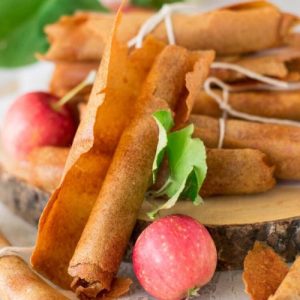
Apple Fruit Leather
Sweet, chewy, and packed with natural apple flavor, this easy apple fruit leather recipe makes the perfect healthy snack. Made from real fruit, lightly sweetened with honey, and infused with cinnamon, it’s a fiber-rich, portable treat everyone will love. Ideal for school lunches, travel snacks, or a homemade pantry staple.
Equipment
- 1 high-powered blender or food processor
- 1 dehydrator with trays (or oven option)
- 1 nonstick spray bottle (or parchment paper)
- 1 Measuring cup set
- 1 Measuring Spoon Set
- 1 spatula
- 1 resealable storage bag or airtight container
Ingredients
- 4 cups chopped apples cored and seeded
- 1 tablespoon honey or maple syrup for vegan option
- 1 teaspoon ground cinnamon
- ½ cup water
Instructions
- Prepare and Clean the Apples: Start by selecting fresh, crisp apples—any sweet or mildly tart variety such as Honeycrisp, Fuji, or Gala works beautifully. Wash the apples thoroughly under cool running water to remove any dirt or wax coating. Pat them dry with a clean kitchen towel. Core and seed the apples using an apple corer or small paring knife, then chop them into evenly sized pieces, about 1-inch chunks. This helps them blend smoothly and evenly later on. You can leave the skin on for added fiber and nutrients, as it will puree seamlessly into the mixture.
- Blend the Fruit Mixture Until Smooth: Transfer the chopped apples into a high-powered blender or food processor. Add the honey (or maple syrup if you prefer a vegan version), ground cinnamon, and water. The water helps the apples break down more easily and prevents the mixture from becoming too thick. Secure the lid tightly and blend on high speed for 1–2 minutes, pausing occasionally to scrape down the sides with a spatula. Continue blending until the mixture becomes completely smooth and glossy, with no visible chunks or bits of fruit remaining. The texture should resemble a thick applesauce—rich, velvety, and pourable.
- Prepare the Dehydrator Trays: Lightly spray your dehydrator trays with a thin layer of nonstick cooking spray to prevent sticking, or line each tray with parchment paper if preferred. If your dehydrator includes special plastic fruit leather sheets, those work perfectly for this recipe. Make sure the trays are level and free of wrinkles in the lining, as any unevenness can cause the fruit leather to dry irregularly.
- Spread the Apple Puree Evenly: Using a spatula, pour the blended apple mixture onto the prepared dehydrator trays. Spread it gently and evenly into a thin, smooth layer about ¼ inch thick. Avoid spreading it too thick, or the leather will take much longer to dry and may remain sticky in the center. Likewise, avoid spreading it too thin, or it may become brittle once dried. Take your time to even out the edges for consistent drying and an attractive, uniform finish.
- Dehydrate the Apple Leather Slowly: Carefully place the trays into the dehydrator and set the temperature to 140°F (60°C). Allow the fruit leather to dry for approximately 3 to 4 hours, checking occasionally after the 3-hour mark. The exact drying time will depend on the thickness of the puree and the humidity level in your kitchen. The fruit leather is ready when it feels smooth, pliable, and no longer sticky to the touch. It should peel easily away from the tray without tearing. If any spots still feel tacky, let it dehydrate for an additional 30 minutes to 1 hour.
- Cool and Peel the Fruit Leather: Once the fruit leather is fully dried, remove the trays from the dehydrator and allow them to cool for about 10–15 minutes at room temperature. Cooling makes it easier to handle and helps prevent condensation when storing. Gently lift one edge of the fruit leather using your fingers or a spatula, and carefully peel it off the tray or parchment paper in one smooth sheet. If the sheet feels too sticky, it may need a bit more drying time.
- Cut and Roll the Leather for Storage: Lay the peeled fruit leather flat on a clean sheet of parchment paper. Use kitchen scissors or a sharp knife to cut it into long strips or desired shapes. For the classic fruit roll-up style, cut into 1–2 inch wide strips, then roll each piece tightly with the parchment paper still attached. This prevents them from sticking together. You can also cut the leather into squares for quick grab-and-go bites.
- Store Properly for Maximum Freshness: Transfer the rolled or cut fruit leathers into an airtight container, resealable plastic bag, or glass jar. If storing multiple rolls together, layer parchment paper between them to prevent sticking. Keep them at room temperature for up to 2 weeks, refrigerated for up to 2 months, or frozen for up to 6 months. For best texture, allow refrigerated or frozen fruit leathers to come to room temperature before enjoying—they’ll regain their soft, chewy texture.
Notes
- Choose firm, fresh apples for the best flavor and texture. Varieties like Honeycrisp, Fuji, or Gala provide natural sweetness, reducing the need for added sugar.
- Keep the apple skins on for extra fiber and nutrients—the blending process makes them completely smooth.
- For a vegan version, swap honey with pure maple syrup or agave nectar without altering taste or texture.
- The ideal puree thickness is about ¼ inch; thicker layers take longer to dry and may stay sticky inside.
- If using an oven instead of a dehydrator, set it to the lowest temperature (around 140–170°F) and prop the door slightly open to allow moisture to escape.
- When drying in humid weather, allow extra time—patience ensures the perfect chewy texture.
- If you prefer a tangier flavor, add a squeeze of lemon juice to balance the sweetness of the apples.
- Use parchment paper for easy removal and clean edges when peeling the fruit leather off the trays.